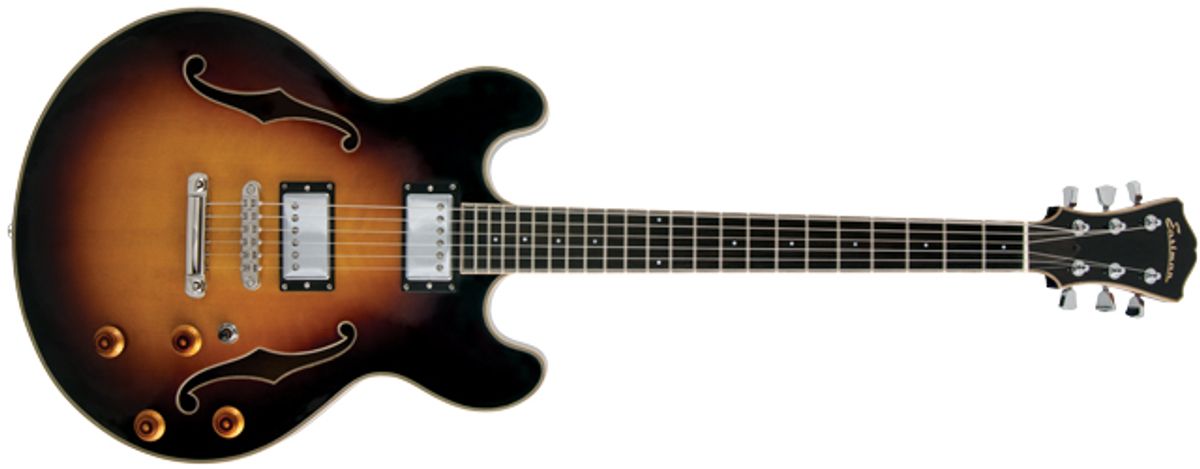
The new Eastman T185MX is an all-solid-wood 15" thinline that channels the rich sound of a full-bodied archtop.
Back in 1992, Eastman Strings began selling violin-family instruments that were built by hand with minimal assistance of power tools. So it was only natural—given the design, structural, and construction attributes archtops share with violins—that Eastman would enter the archtop market a decade later.
While archtops remain the cornerstone of the Eastman line, the company has grown to offer a range of fine flattop guitars from parlors to jumbos. More recently, Eastman unveiled a family of thinline electrics. That’s a pretty logical evolution for a company that’s made a name in affordable, high-quality archtops. But when we checked out the T185MX, an all-solid-wood 15" thinline that channels the rich sound of a full-bodied archtop, we were tempted to wonder why they didn’t make the move sooner.
Fancy and Familiar
At a glance—with its double cutaways,
dual-humbucker electronics package, Tune-o-matic-style bridge, and stop tailpiece—the
T185MX resembles the mother of all thinlines,
the Gibson ES-335. But the T185MX
deviates from the classic Gibson’s build formula
in many respects. Rather than laminate
maple and poplar for the body construction,
the 15" T185MX has a two-piece
back carved from solid mahogany (with
beautiful figuring), mahogany sides, and a
carved maple soundboard. The T185MX is
also fully hollow, with a small block underneath
the bridge and tailpiece, more like an
ES-330 or Epiphone Casino.
There’s no shortage of cosmetic niceties on the T185MX. In place of plastic binding, the body is wrapped in figured maple binding with a pair of black pinstripes—an elegant flourish that’s repeated, albeit with a single black line, around the f-holes, fretboard, and headstock face. Clean pearl-micro-dot position markers stud the ebony fretboard, the same wood used for the truss-rod cover. And an Eastman logo inlaid in maple graces the headstock, which has the sort of bold, dramatic flair of an old D’Angelico.
Overall, the T185MX is a well-built instrument. The fretwork was tidy, if just a tad jagged at a few edges. The finish was smoothly buffed and free of any apparent orange-peel effect, but there were a few less-than-well-executed areas. In spots, the sunburst finish encroached unevenly on the binding and there appeared to be a slight excess of glue at the neck joint. That said, these cosmetic details had no bearing on what is otherwise a great-playing guitar.
Not surprisingly, the hollowbody Eastman is very light, weighing just 6.3 pounds. And as a longtime ES-335 player, the T185MX felt immediately comfortable and familiar, even though its light weight, longer 25" scale length, and more slender waist are all significant differences. The C-shaped neck, which is similar to the neck profile you’d encounter on an early ’60s Gibson thinline, felt sleek and fast in all registers. It was equally accommodating of complex barre-chord shapes, speedy single-note excursions, and deep bends, even though it comes equipped with .011 D’Addario strings rather than the customary .010s you’d expect.
Ratings
Pros:
Great sounds and playability in an extremely comfortable, all-solid-wood thinline.
Cons:
Craftsmanship imperfections.
Tones:
Playability:
Build/Design:
Value:
Street:
$1,600
Company
eastmanguitars.com
Thin Lines, Fat Tones
The T185MX is a pleasure to play
unplugged. It has impressive sustain and
presence without an amp. Individual notes
across all 22 frets sounded crisp and clear,
and there was excellent note articulation in
complex chords. Few electric guitars are this
satisfying to pick at while stationed in front
of the television.
Once plugged into a Fender Pro Junior, the Seymour Duncan ’59s T185MX really came alive. With the neck pickup engaged, the guitar broadcasts a rich jazz tone that’s a bit more complex than what you typically hear from a laminated thinline. It’s perfect for everything from Wes Montgomery–style thumb-picked octaves to Joe Pass chord-melody solos—a plus for those who want a classic jazz tone but don’t enjoy the heft and girth of a traditional archtop.
The T185MX is nothing if not adaptable, and it excels in myriad musical contexts. The bridge pickup has an articulate bark that’s never harsh and lends itself to everything from chicken-pickin’ and stripped-down punk to fingerstyle blues, depending on your attack and where you set the responsive and wide-ranging tone control. Better still, it can deliver the authoritative voice and response of a solidbody without sacrificing the warm woodiness of its hollow body. With the pickups in tandem, the tone controls rolled back, and an Ibanez Tube Screamer in the mix—the Eastman served up a sweet and fat variation of Clapton’s classic “woman tone.” And played at high volumes, the guitar was surprisingly resistant to the most screeching feedback while remaining capable of very musical feedback that’s a blast to control via amplifier proximity.
The Verdict
Eastman’s T185MX is an attractive, alternative
twist on the classic, laminated semi-hollow
formula. The slender neck and
slightly slimmer body make it fast and easy
to play. And the all-solid-wood construction
and Seymour Duncan pickups generate
a deeply resonant voice that’s delightfully
full of range and musical possibilities.
The $1,600 price tag may seem a little
steep for an imported axe, but the solid-wood
construction—which adds to the
price—does seem to pay sonic dividends.
The refreshing design guarantees you’ll
cut a unique profile on stage too. And
given the plethora of tones lurking within
the T185MX, this may be the only guitar
you’ll ever need in a stage situation. That
kind of versatility can be hard to sum up in
dollars alone.


